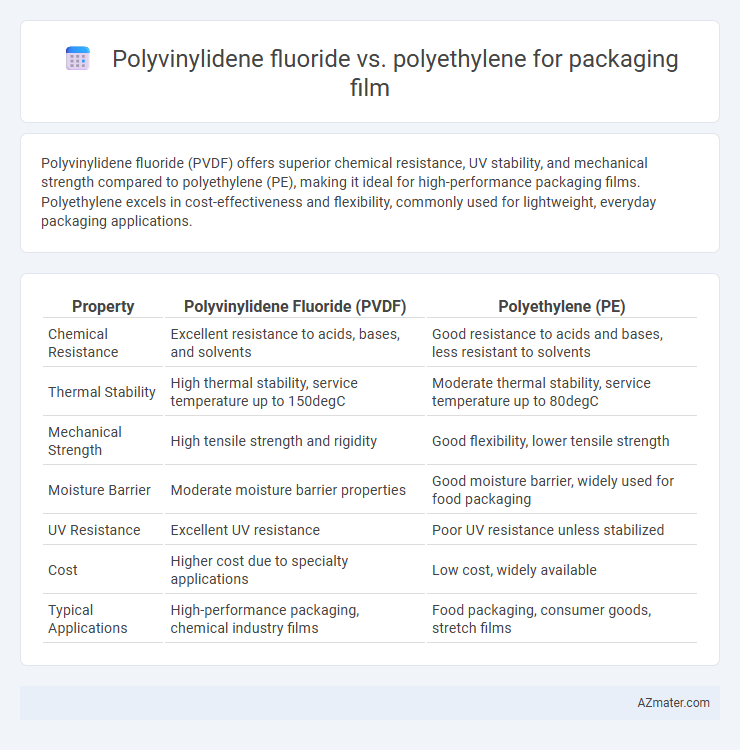Polyvinylidene fluoride (PVDF) offers superior chemical resistance, UV stability, and mechanical strength compared to polyethylene (PE), making it ideal for high-performance packaging films. Polyethylene excels in cost-effectiveness and flexibility, commonly used for lightweight, everyday packaging applications.
Table of Comparison
| Property | Polyvinylidene Fluoride (PVDF) | Polyethylene (PE) |
|---|---|---|
| Chemical Resistance | Excellent resistance to acids, bases, and solvents | Good resistance to acids and bases, less resistant to solvents |
| Thermal Stability | High thermal stability, service temperature up to 150degC | Moderate thermal stability, service temperature up to 80degC |
| Mechanical Strength | High tensile strength and rigidity | Good flexibility, lower tensile strength |
| Moisture Barrier | Moderate moisture barrier properties | Good moisture barrier, widely used for food packaging |
| UV Resistance | Excellent UV resistance | Poor UV resistance unless stabilized |
| Cost | Higher cost due to specialty applications | Low cost, widely available |
| Typical Applications | High-performance packaging, chemical industry films | Food packaging, consumer goods, stretch films |
Introduction to Packaging Films: Polyvinylidene Fluoride vs Polyethylene
Polyvinylidene fluoride (PVDF) offers superior chemical resistance, UV stability, and high-temperature performance compared to polyethylene (PE), making PVDF ideal for specialized packaging applications requiring durability and protection against harsh environments. Polyethylene remains widely used in packaging due to its cost-effectiveness, flexibility, and excellent moisture barrier properties, suitable for everyday consumer goods. The choice between PVDF and PE depends on specific packaging needs, balancing economic factors with performance requirements such as longevity, chemical exposure, and environmental conditions.
Chemical Structure and Composition
Polyvinylidene fluoride (PVDF) and polyethylene (PE) differ significantly in chemical structure, with PVDF being a fluoropolymer composed of repeating units of -(CH2-CF2)-, offering high chemical resistance and thermal stability due to the strong carbon-fluorine bonds. In contrast, polyethylene consists of simple hydrocarbon chains with repeating -(CH2-CH2)- units, providing excellent flexibility and moisture barrier properties but lower resistance to solvents and heat. The fluorine atoms in PVDF enhance its durability and resistance to UV radiation and corrosive chemicals, making it suitable for specialized packaging applications compared to the more widely used, cost-effective polyethylene.
Mechanical Strength and Durability
Polyvinylidene fluoride (PVDF) offers superior mechanical strength compared to polyethylene (PE), with higher tensile strength and greater resistance to abrasion, making it ideal for heavy-duty packaging applications. PVDF also exhibits excellent chemical resistance and UV stability, enhancing its durability in harsh environments where PE may degrade or lose structural integrity over time. While polyethylene remains cost-effective and versatile for general packaging use, PVDF's robustness ensures longer service life and improved protection for high-value or sensitive products.
Barrier Properties: Moisture, Oxygen, and Chemicals
Polyvinylidene fluoride (PVDF) exhibits superior barrier properties against moisture, oxygen, and chemicals compared to polyethylene (PE), making it ideal for high-performance packaging films. PVDF's dense molecular structure significantly reduces moisture vapor transmission rate (MVTR) and oxygen permeability, enhancing shelf life for sensitive products. In contrast, polyethylene offers moderate barrier protection, primarily against moisture, but is less resistant to oxygen and chemical permeation, limiting its use in demanding packaging applications.
Transparency and Aesthetic Qualities
Polyvinylidene fluoride (PVDF) exhibits superior transparency and clarity compared to polyethylene, making it ideal for packaging films that require high visibility and aesthetic appeal. PVDF films maintain excellent color retention and resist yellowing under UV exposure, enhancing long-term product presentation. In contrast, polyethylene films often appear hazier and less vibrant, limiting their use where premium visual quality is essential.
Thermal Stability and Temperature Resistance
Polyvinylidene fluoride (PVDF) exhibits superior thermal stability and temperature resistance compared to polyethylene (PE), maintaining performance at temperatures up to 150degC, while polyethylene typically degrades around 80-100degC. PVDF's crystalline structure and strong carbon-fluorine bonds contribute to its high heat deflection temperature, making it ideal for packaging requiring prolonged exposure to elevated temperatures. In contrast, polyethylene's lower melting point and susceptibility to thermal degradation limit its use in high-temperature packaging applications.
Processability and Manufacturing Efficiency
Polyvinylidene fluoride (PVDF) offers superior chemical resistance and UV stability compared to polyethylene, enhancing packaging film durability but requires higher processing temperatures due to its crystalline nature. Polyethylene, known for its ease of melt processing and lower manufacturing energy consumption, enables faster production cycles and cost-effective film extrusion. The choice between PVDF and polyethylene impacts manufacturing efficiency, balancing PVDF's robust performance with polyethylene's streamlined processability for high-volume packaging applications.
Environmental Impact and Recyclability
Polyvinylidene fluoride (PVDF) offers superior chemical resistance but poses recycling challenges due to limited industrial processes and its fluorinated structure, which can release harmful compounds if incinerated. Polyethylene (PE), widely used in packaging films, benefits from well-established recycling streams and lower environmental toxicity, making it more eco-friendly and easier to integrate into circular economies. The environmental impact of PE is generally lower given its biodegradability potential and widespread recovery programs compared to PVDF's persistence and energy-intensive production.
Cost Comparison and Market Availability
Polyvinylidene fluoride (PVDF) packaging films generally exhibit higher costs than polyethylene (PE) films due to their superior chemical resistance, thermal stability, and barrier properties. Polyethylene remains the dominant choice in packaging applications because of its affordability, wide availability, and ease of processing, making it cost-effective for high-volume production. Market availability for polyethylene packaging film is extensive globally, while PVDF films are more niche, primarily used in specialized industries where performance justifies the premium price.
Application Suitability in the Packaging Industry
Polyvinylidene fluoride (PVDF) offers superior chemical resistance, UV stability, and thermal durability, making it highly suitable for packaging films designed for harsh or outdoor environments. Polyethylene (PE), particularly low-density and high-density variants, provides excellent flexibility, moisture barrier properties, and cost-effectiveness, which are ideal for general-purpose packaging applications. While PVDF is preferred for specialty packaging requiring enhanced protection and longevity, polyethylene remains dominant for everyday packaging due to its versatility and economic advantages.

Infographic: Polyvinylidene fluoride vs Polyethylene for Packaging Film
 azmater.com
azmater.com